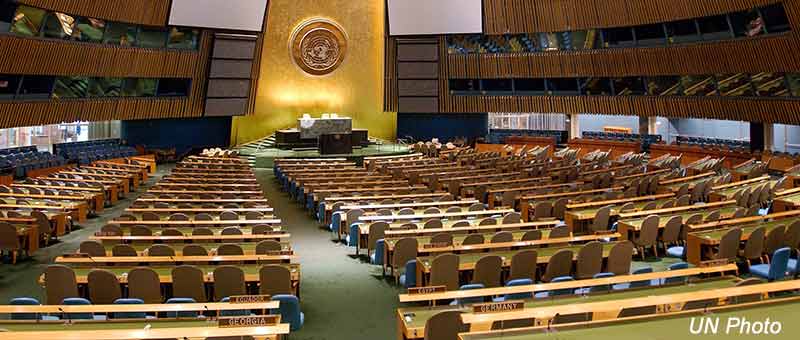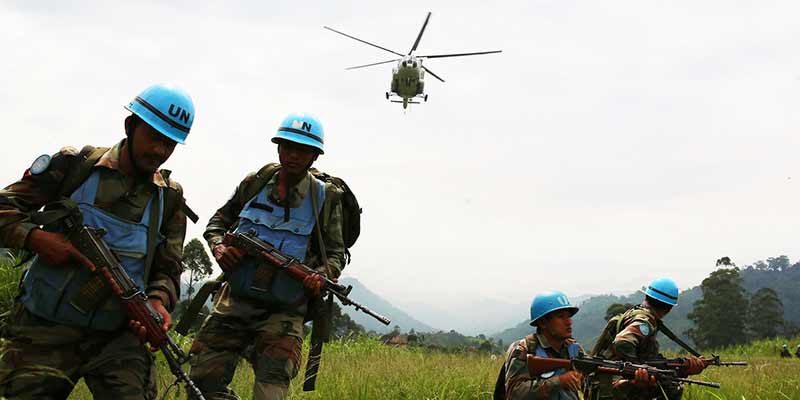- World
- Jun 15
UNGA adopts resolution introduced by India to honour fallen peacekeepers
• The United Nations General Assembly has adopted by consensus a draft resolution piloted by India to establish a memorial wall in the UN headquarters to honour fallen peacekeepers.
• India’s Permanent Representative to the UN Ambassador Ruchira Kamboj introduced the draft resolution titled ‘Memorial wall for fallen United Nations peacekeepers’ on June 14 in the UN General Assembly Hall and it was adopted by consensus.
• The resolution pointed out that more than one million men and women from 125 countries have served in 71 peacekeeping missions worldwide. Even today, over 80,000 peacekeepers serve in various conflict zones, enduring harsh conditions and risking their lives to keep the peace.
• However, this has not been without its cost — more than 4,200 peacekeepers have laid down their lives in the service of the blue flag. These brave men and women — who came from different parts of the world, practice different faiths and follow different cultures — were united by the cause of peace, their spirit of selfless sacrifice, professionalism and resolve.
• The General Assembly welcomed the initiative to establish a memorial wall at United Nations Headquarters in New York honouring the memory of fallen peacekeepers.
What is UN peacekeeping?
• UN peacekeeping helps countries torn by conflict create conditions for lasting peace. Peacekeeping has proven to be one of the most effective tools available to the UN to assist host countries navigate the difficult path from conflict to peace.
• It is a unique global partnership. It brings together the General Assembly, the Security Council, the Secretariat, troop and police contributors and the host governments in a combined effort to maintain international peace and security.
• The first UN peacekeeping mission was established in May 1948, when the UN Security Council authorised the deployment of a small number of UN military observers to the Middle East to form the United Nations Truce Supervision Organisation (UNTSO) to monitor the Armistice Agreement between Israel and its Arab neighbours.
• In over 70 years, more than one million men and women have served under the UN flag in more than 70 UN peacekeeping operations. More than one lakh military, police and civilian personnel from 125 countries currently serve in 13 peacekeeping operations.
• In the early years, UN Peacekeeping’s goals were primarily limited to maintaining ceasefires and stabilizing situations on the ground so that efforts could be made at the political level to resolve the conflict by peaceful means. Those missions consisted of military observers and lightly armed troops with monitoring, reporting and confidence-building roles in support of ceasefires and limited peace agreements. Troops and police came from a relatively small number of countries and they were mostly men.
• Over the years, UN Peacekeeping has adapted to meet the demands of different conflicts and a changing political landscape. Today’s multidimensional peacekeeping operations are called upon not only to maintain peace and security but also to facilitate the political processes, protect civilians, disarm combatants, support elections, protect and promote human rights and restore the rule of law.
• Peacekeeping has unique strengths, including legitimacy, burden sharing, and an ability to deploy and sustain troops and police from around the globe, integrating them with civilian peacekeepers to advance multi-dimensional mandates.
• The International Day of UN Peacekeepers is observed on May 29. On this day in 1948, the first UN peacekeeping mission named the ‘United Nations Truce Supervision Organisation’, or UNTSO, began operations in Palestine.
What are the duties of peacekeepers?
• UN peacekeepers (often referred to as Blue Berets or Blue Helmets) provide security and the political and peacebuilding support to help countries make the difficult, early transition from conflict to peace.
• While most peacekeepers are serving in the military or police, 14 per cent are civilians who perform a wide range of functions, from serving as the civilian leadership of the mission to working in the areas of political and civil affairs, human rights, elections, strategic communications, IT, logistics, transport and administration and more.
• Women peacekeepers today play an increasingly prominent role and are crucial towards improving the performance of the missions. They serve as police officers, troops, pilots, military observers, and other uniformed and civilian posts, including in command positions.
• With its expanded role and operations in some of the world’s most challenging environments, peacekeepers face considerable risks.
India’s role in UN peacekeeping
• Commencing with its participation in the UN operation in Korea in 1950, India has a long and distinguished history of service in UN peacekeeping, having contributed more personnel than any other country, as well as the first-ever all-female force that helped to bring peace to Liberia in the wake of that country’s brutal civil war.
• From 2007-2016, there were nine rotations of all-female police units from India, whose primary responsibilities were to provide 24-hour guard duty, public order management and conduct night patrols in and around the capital of Liberia, Monrovia, while assisting to build the capacity of local security institutions. Hailed as role models, these female officers not only played a vital role in restoring security in the West African nation but also contributed to an increase in the number of women in the country’s security sector.
• More than 2 lakh Indians have served in peacekeeping missions established around the world.
• Medical care is among the many services Indian peacekeepers provide to the communities in which they serve on behalf of the UN. They also perform specialised tasks such as veterinary support and engineering services.
• India has also provided 15 Force Commanders to various missions, and was the first country to contribute to the Trust Fund on sexual exploitation and abuse, which was set up in 2016.
• Over 160 Indian peacekeepers have lost their lives while serving with the UN.
Manorama Yearbook app is now available on Google Play Store and iOS App Store



